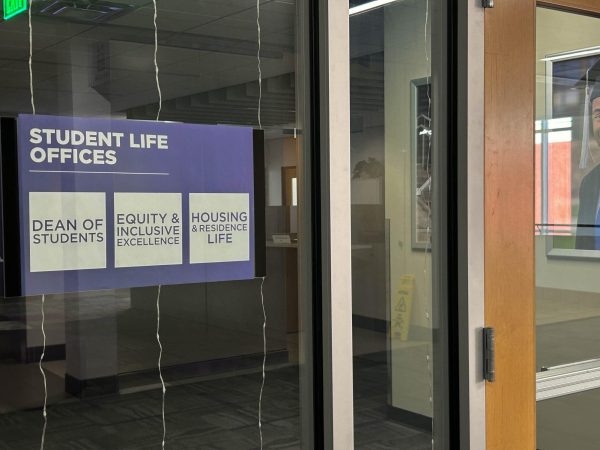Budget forum gives answers
October 30, 2019
Winona State University held its first budget forum of the 2019-20 school year on Tuesday, Oct. 22 in the Haake Hall conference room.
The forum was planned to further explain the university’s current $1.6 million budget deficit and answer questions from the public.
Scott Ellinghuysen, chief financial officer, presented to a near-capacity room of university employees, students and community members.
Ellinghuysen said the deficit occurred due to many factors, including limited resources and varying investment needs. These factors include fluctuating monetary support from the state, shifting enrollment demographics and healthcare cost escalation, among others.
Ellinghuysen emphasized a major impediment to the university’s budget: the increase in Winona State’s health insurance budget.
Winona State has projected a 7.6% rise in health care coverage in FY21-22 – a $900,000 increase.
That increase means family coverage per employee will exceed $20,000 a year. Just to cover the projected increase in health care, there would need to be a 1.7% increase in student tuition and a 2.6% increase in state appropriation.
The university hopes to receive monetary support from the state after putting in a request to the MN State Board of Trustees.
The request includes $23 million to fund a tuition freeze, $16.7 million for campus support – adding $850,000 to the Winona State budget – and $14.5 million for ISRS Next Gen funding.
The last major facet of the numerous causes of the deficit is shifting enrollment demographics.
Enrollment demographics have steadily declined for Winona State for years.
While general enrollment remained steady near 7,000 students for both FY20 and FY21, this plateau comes after an overall 1,500 enrollment drop since 2013.
Incoming first-year student statistics are on the rise since 2018 with a projection for the 2020 school year to bring in 1,600 students. The peak of incoming first-year students was in 2013 with 1,657 students.
Transfer student enrollment has also steadily declined since the 2013 peak of 628 students, down to 456 students in 2019. This was a noticeable drop from 540 students in 2018.
The university’s plan to address and deal with the budget situation was to first discuss with the finance committee and bargaining units, then release budget emails to the campus and schedule budget forums.
Ellinghuysen released budget information emails to all faculty over a month ago, then to students about two weeks after that.
Following the budget forum held on Winona State’s campus Oct. 22, WSU-Rochester also held a forum Thursday, Oct. 24.
The next steps, Ellinghuysen said, now focus on reviewing the current situation and establishing a plan for reductions.
Three budget scenarios were presented during the forum to deal with the deficit, as well as specific numbers and details on what those scenarios would mean for faculty and students for the years to come.
Each plan, simply called A, B and C, proposed different budget reductions.
Scenario A proposed a 3% increase in tuition, raising $1.6 million in revenue for the university, and decreasing the deficit to $2.9 million.
Scenario B proposed a 1.5% increase in tuition, raising $800,000 in revenue, and decreasing the deficit to $3.7 million.
Scenario C proposed a 0% increase, raising $0 in tuition, leaving the school at its $4.5 million deficit. However, it would also allow students the comfort of paying a steady rate following the 3% increase that already occurred for this school year.
Winona State boasts affordable tuition rates.
“It’s not that bad. And we’ll do everything in our power to make it even more affordable,” the Winona State website states.
After a 6% increase in tuition in the last two years on top of the discussion to raise tuition at the budget forum on Tuesday, that boast may be invalidated.
“We’re forecasting a 3% tuition increase next year,” Ellinghuysen said.
Next, each department head will need to create reduced budget plans for their departments to be approved by the university’s cabinet by the beginning of December.
The cabinet will review and assess each department’s plan and a final proposal will be made by Feb. 1, 2020.
The university’s current goal is to have reductions in place by July 1, 2020.
Funding is broken up into two pieces: state appropriation funding and tuition revenue from students. State appropriation is about $35 million and tuition revenue is about $55 million, i.e. 40% funded by state and 60% funded by students.
The university’s general fund is in the low $90 millions.
Compensation – employee and staff salaries, benefits, etc. – take up $75 million of that.
The general fund budget is what funds every department and office of the university.
Academic affairs makes up 73.1% of funding which includes each college, the library, technology resources, etc.
The president’s office receives 26.8% for finance and administration, athletics, etc.
The colleges of liberal arts, science and engineering, nursing and health sciences currently receive the largest percentage of the general fund budget.
Facing reductions, those three departments also stand to lose the most.
In the worst-case scenario of a $5 million budget reduction, the college of liberal arts would lose nearly $1 million of its funding. Following that, the science and engineering college faces a loss of $628,136, and the nursing and health sciences college faces a $470,243 loss.
Olson went on to remind those of a similar budget reduction situation the university faced two years ago, and while then similar concerns regarding layoffs seemed unavoidable, they were ultimately able to steer clear of layoffs. He said he is positive the school will be able to do so again.
“The first thing is to minimize harm to students,” Olson said. “Number two is to minimize harm to employees.”
More budget forums will be scheduled in February and March to share final budget decisions.





































































